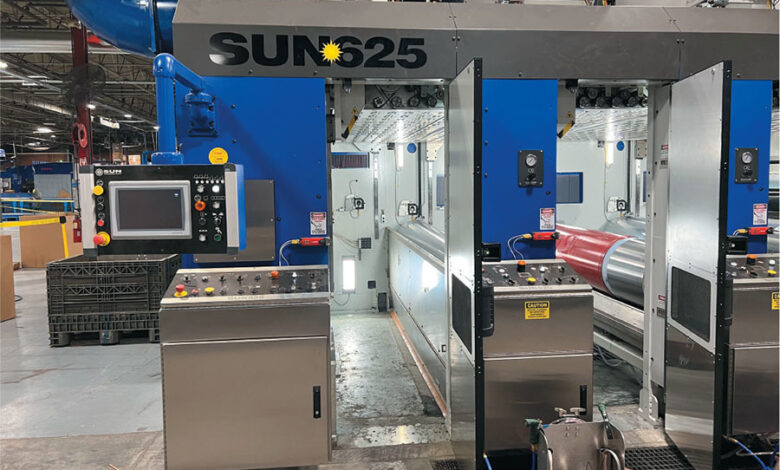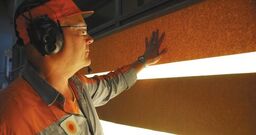Managing a Successful Rotary Die Cut Operation


Rotary die cutters are often referred to as “the workhorses” of the corrugated industry. Their successful operation should not be taken for granted. In this article I would like to offer some sound technical support. My focus is to improve our manufacturing environment, reduce waste, improve registration, and ensure the performance of the rotary cutting dies.
Several items need to be understood to manage a consistent and profitable rotary die cut operation. They include:
- Managing sheet caliper during the die cutting process
- Managing and understanding accurate registration
- Managing proper mounting procedures
- Understanding “rubbering”
- Enhancing the performance of cutting dies.
The subject and design criteria for rotaries has grown immensely in the last 10-12 years. Cutting die manufacturers have also responded aggressively in response to industry demands. The entire concept of marketing customers’ products through box design and display techniques has matured into a whole new platform. As an industry, we need to review the requirements, raise our standards, and offer our customers first class, accurate, and clean die cut products. Properly done, this process will add real value to our RSCs, improve our competitive position in the marketplace, and contribute to the bottom line.
MANAGING CALIPER
Every machine center must focus on recording and minimizing caliper loss in the converting process. Maximum allowable caliper loss is 0.003″ (0.008 mm). Each order should be measured for sheet caliper, as there are many different paper combinations that we are converting today. C-flute is not always C-flute; it can vary anywhere from 0.155″ (3.9 mm) to 0.172″ (4.3 mm) depending on the box requirements and the required paper combination. Operators need to be aware of the differences so that the nips can be set for each order.
We need to cut cleanly and accurately so customers get a box or display they will not only pay for, but will buy again. The design of the cutting die is based on a certain caliper sheet and if we change that caliper, how can we expect to die cut accurately? Supervisors need to be sure that this is part of the culture on the production floor; it needs to be done on every order. Sample triangles, three inches on a side, need to be displayed so that management can see them on the table for good process control.
GOOD REGISTRATION PRACTICES
Die cut registration or inaccurate registration is a major cause of scrap and unscheduled downtime. Running and managing the die cutting process requires proper understanding of accurate registration, which means proper time and register calibration, proper registration numbers on the cutting dies, and controlled sheet transfer throughout the color stations.
Work with your die suppliers to be sure that they locate the zero-register number (registration number) on the lead edge of the wood on the operator’s side. This makes it easy for the operator to read and use as part of the setup process. Be sure that the crews understand this number and enter it into the machine control center. (The zero-registration number is calculated as follows: Measure the distance from the centerline of the first row of bolt holes on the wood to where the product begins; subtract that number from the cylinder size and add the lead edge trim.) Crews should mount the cutting die as follows: The first row of bolt holes on the wood is to be mounted over the zero row of bolt holes on the die drum.
It is important to accurately control the sheet as it travels through the print stations. Be sure to use low profile pull bands on the active print stations. Use pull band printing plates on the inactive print stations. This practice will assure an accurate arrival of the sheet in the die cut section of the press.
Be sure that your die supplier prints the zero-register number on all cutting dies including the presses smaller than the 66″ (1600 mm) die cutters. For some reason, die suppliers seem to think that we do not need to set the register on flexos in the die cut section, and we all know that is wrong.
PROPER MOUNTING
One area that needs improvement in our industry is mounting cutting dies on the die drum. Operators rarely completely and properly mount cutting dies on the cylinder. They only use a portion of the mounting holes in the wood, and this leads to a number of “silent” production issues, such as slower running speeds, uneven die cutting, scrap, and cutting dies that wear out prematurely.
Cutting dies should last around one million impressions. If the wood is not snug against the cylinder, the tooling in the wood will move up and down every revolution and eventually become loose. It then must be repaired at a cost or maybe just replaced. Loose tooling always results in poor die cutting.
Review the annual costs of cutting dies in your plant. Depending upon the size of your production floor and the number of converting machines, the annual cost can vary from US$75,000 up to US$200,000 or more. These are real numbers and either contribute to or take away from your bottom line. These costs are hard, if not impossible, to trace, but are certainly real numbers.
It is important that a bolt is put in every hole location in the wood. Good diemakers will locate as many holes as they can to properly support the process without jeopardizing the integrity of the cutting die. So, a good operator will maximize the performance of that tool by using every hole. Operators tell me that if they put a bolt in every hole, it adds to their setup time—yet vacant holes result in slower running speeds. My response is: take the 45 seconds additional setup time and then run the order at a proper speed of 200+ kicks per minute. Otherwise, run with vacant holes and run at slow speeds of 150 kicks per minute or less.
Also, use the hammer and hollow sound test to assure proper mounting. If you tap the wood with a hammer and the sound is hollow, that means there is space between the wood and drum. That indicates that the cutting die is not properly mounted. This die cutting process says that, during the process, the knife or scoring rule pushes against the steel drum every revolution for it to work. If the knife or scoring rule is moving up and down because the wood is not properly mounted, the process is wrong and the cutting and scoring process cannot be accurate or clean.
UNDERSTANDING RUBBERING
“Rubbering” in the world of die cutting is not a science but an art. It has several very important functions in the converting process:
- Transport the sheet.
- Maintain register.
- Support the body of the product on the outside of the knife (straight side) as it is being cut.
- Support the inside (bevel side) of the sheet.
- Eject the die cut scrap as it is separated from the sheet.
Pull band rubber controls the sheet in the nip point and assures that the sheet travels the same speed as it enters and exits the die cut section. This is critical as the die cutting continues throughout the process as the sheet enters the die cut section (while under control of a previous nip in the last color station) and while the lead edge of the die cut sheet enters either the folder entrance section in a FFG or the beater section in the rotary die cutter. This is a very important part of the die cutting process.
Support rubber needs to be the same height as the blade so the body of the sheet is properly supported in the cutting process. This generally happens on the non-bevel (straight) side of the knife. Please note: If the sheet is not properly supported, it will move up and down in the process and alter the point of cut and change registration.
Ejection rubber is on the beveled side of the knife and must be higher than the support rubber. This rubber is also closed cell rubber as it needs to be harder so that it can punch out the scrap and aggressively remove it from the sheet.
DIE BOARD PERFORMANCE
The last items—but certainly not the least—are the anvil blankets. They are a major factor in accurate, clean die cutting. Be sure to either rotate the blankets on a scheduled basis or ensure that the proper blanket trimming device is working accurately. Just to be clear: if you trim the blanket, it is necessary that the die cut section is servo driven so that as you trim the blanket and reduce its diameter, the surface speed of the outside diameter is adjusted to match the surface speed of the cutting die.
It is important that all these points are properly managed and supported in the plant at all levels to be sure that you produce a quality product.
Enjoy your job.




